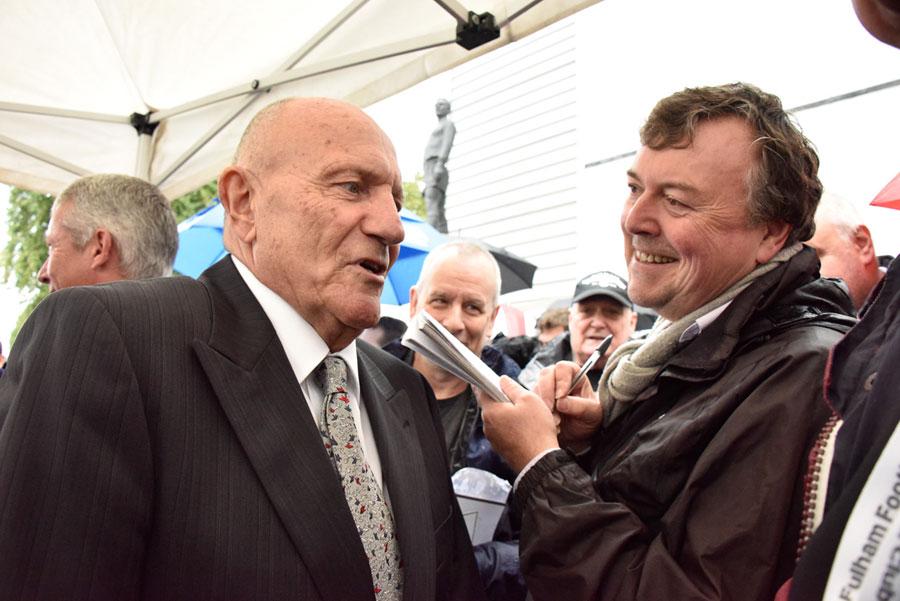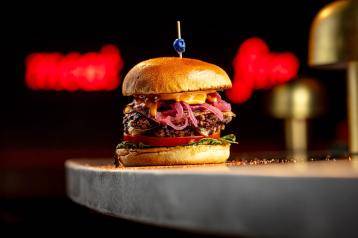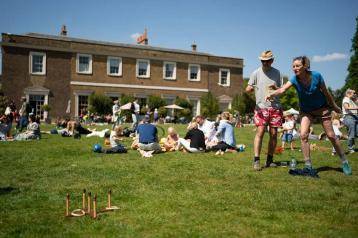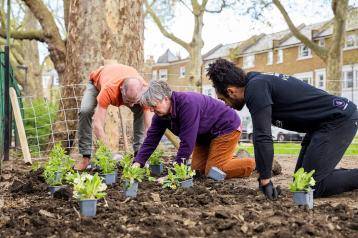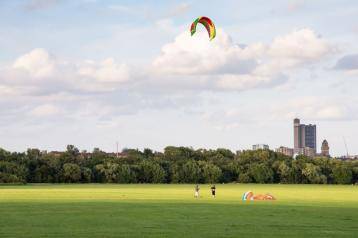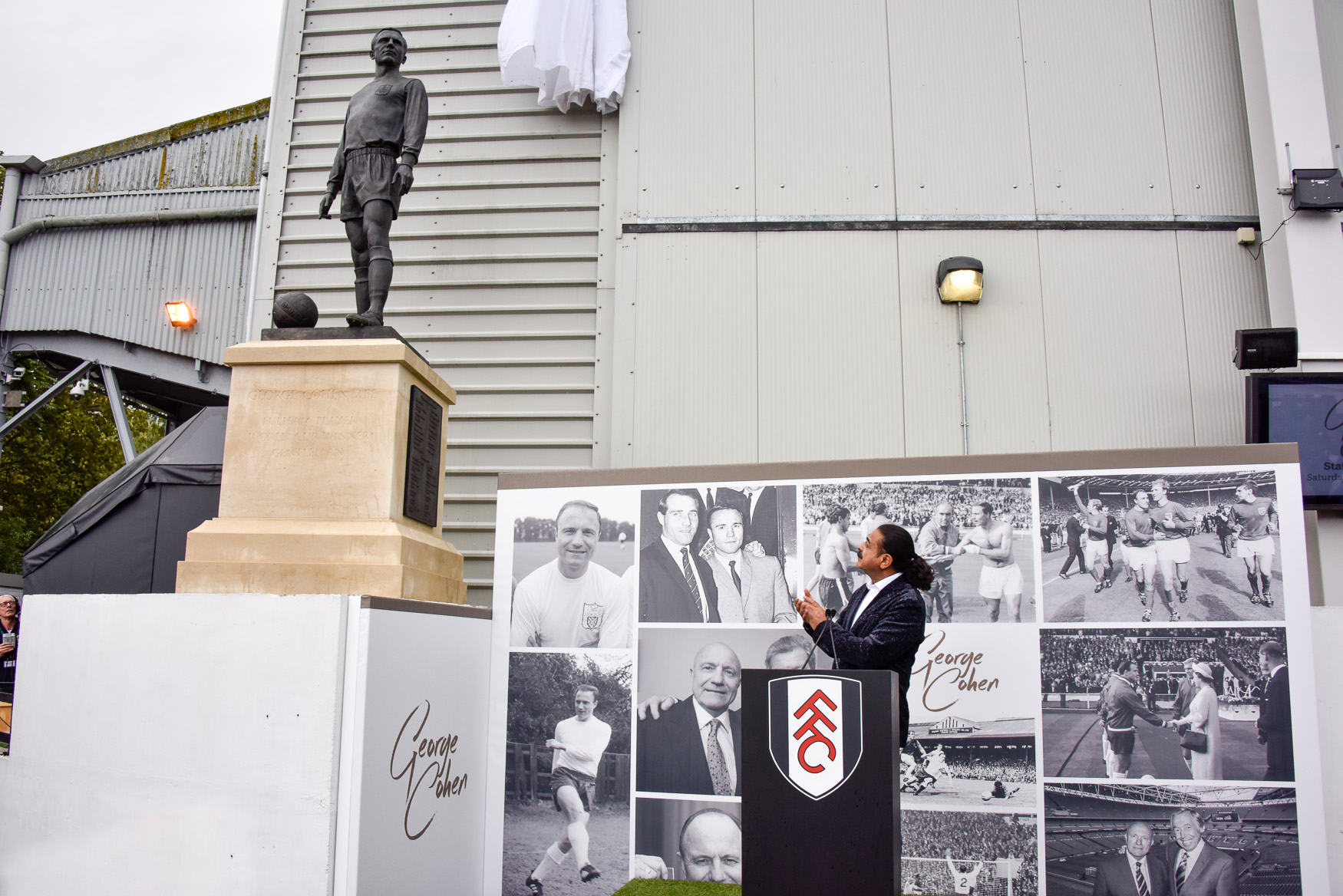
Fulham FC chairman Said Khan unveils the George Cohen statue at Craven Cottage
World Cup winner and Fulham footballing legend George Cohen is being made an honorary freeman – the highest civic distinction that the borough can grant.
The honour will be conferred at a special meeting of Hammersmith & Fulham Council on October 19… three days before the footballer’s 77th birthday.
It follows the unveiling, ahead of the weekend’s west London derby against QPR, of a bronze statue at Cohen’s spiritual home, Craven Cottage.
“This is a richly deserved honour for a sporting hero who is Fulham through and through,” said Cllr Stephen Cowan, Leader of Hammersmith & Fulham Council. “It not only marks his achievements on the football field, but also his ambassadorial role and his tireless campaigning for research into cancer and dementia, especially to help his fellow players.”
George, his wife of 54 years Daphne, sons Tony and Andrew, and a host of grandchildren, former players and friends were at the statue unveiling at Craven Cottage on Saturday.
It means that both Cohen and his former captain at Fulham, Johnny Haynes, are now commemorated in bronze at either end of the famous riverside ground.
Fulham chairman Shahid Khan gave generously to the fund to commission the Cohen statue, and to the former football star’s favourite charity, the Sporting Memories Network, which uses sport to assist those suffering memory impairment.
“George was one of the great full backs of his time, and is beloved beyond measure at the club here,” said Mr Khan in his address to the 100-strong gathering on a rain-spattered Saturday morning.
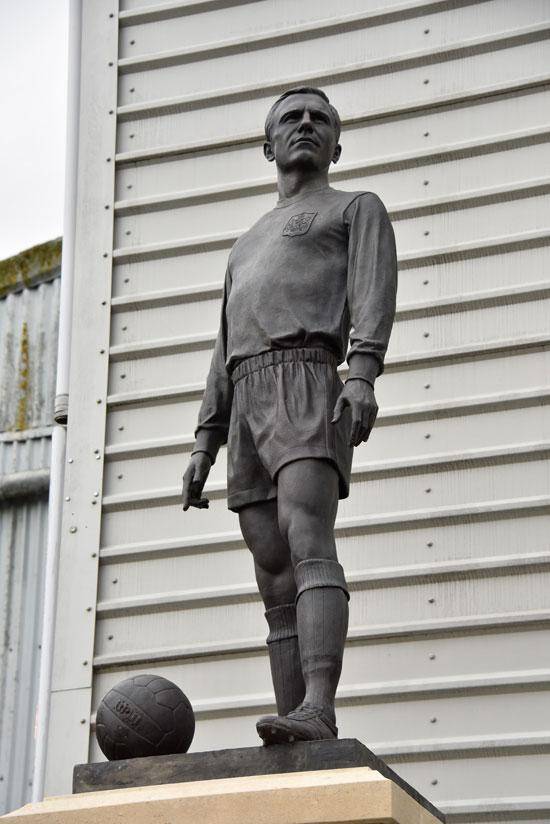
“How many players of his World Cup stature have served just one club?” he asked.
Cohen himself was typically modest and self-deprecating as the sheet was lifted off the statue, revealing the lifesize bronze on a plinth, created by sculptor Douglas Jennings.
“Are you sure it’s not George Clooney,” he joked as he admired the metal figure which stands, proudly and defiantly, on a bathstone plinth, gazing out across the Thames. “That’s far higher than I ever used to jump.”
Born locally, Cohen was indeed a rare one-club man, making 459 appearances for the Whites between 1956 and 1969 before being forced to retire from football at the age of only 29 because of injury. Only five Fulham players have exceeded his tally of club appearances.
George Best, another Fulham star, famously called Cohen ‘the best full back I ever played against’, while Sir Alf Ramsey, who managed England’s 1966 World Cup-winning team, dubbed him ‘England’s greatest right back’.
In the 1980s Cohen fought, and won, a battle with bowel cancer. It spurred him on to campaign for cancer charities, and he now also supports dementia charities too.
Walking with the aid of sticks, he is one of just nine survivors of the 1966 World Cup team… five of whom are suffering different degrees of dementia. It means, insists Cohen, that there will be no further repeats of this summer’s 50-year reunion of World Cup stars. “That was the last,” he said.
“It’s very important that people now know the number of guys from that ’66 squad who are now ‘missing’, you know,” he added, tapping the side of his head. “You just don’t know how many more are going to be like that. At our last get-together it was pretty sad. I’ve still got the memories of 1966, but some of the guys haven’t.”
Yet despite his concerns for his fellow former footballers, George Cohen is an upbeat and positive soul, cheerfully posing for selfies with fans, signing endless autographs (including one in your reporter’s notebook) and joshing and joking with everyone who attended the statue unveiling, among them fellow former Fulham great Tosh Chamberlain, former Fulham and England manager Roy Hodgson and former Fulham and England assistant manager Ray Lewington.
With a mischievous smile, and a wink to Hodgson, Cohen ruled himself out of the vacant England managerial job!
Hodgson is a great admirer of the former England defender. “He’s a legend in Fulham and England terms; I got to know him when I came to Fulham, and he conducts himself so well,” he said. “He’s a great ambassador, and I’m so pleased to see that he’s got a statue; it’s richly deserved.”
Ray Lewington added: “So few in this country can claim to have a World Cup winner’s medal. We couldn’t be talking about a nicer man; he’s very modest and never mentions his achievements.”
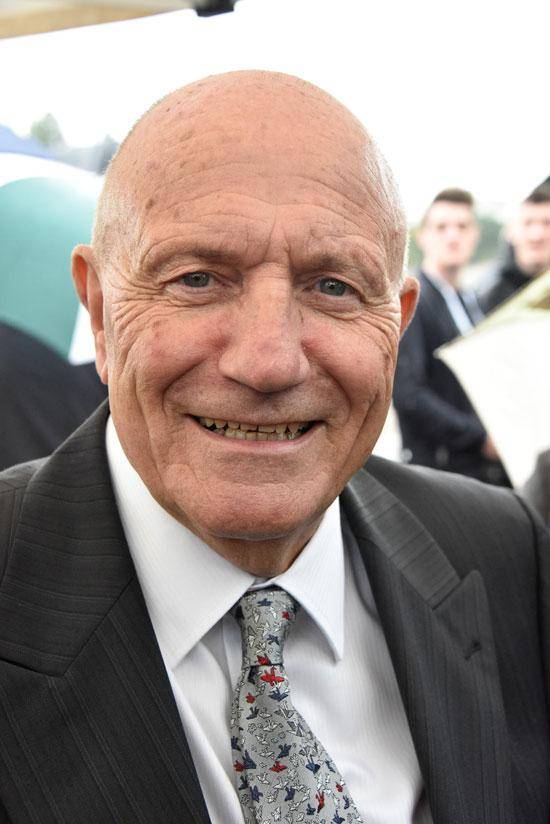
And of Cohen’s campaign to find ways of combating dementia, Lewington said: “My mum died, having dementia. It’s the worst disease; you’re fit in body, but not up here. It’s a terrible disease.”
Summing up George Cohen’s modesty, one of his old playing colleagues whispered: “He told me that what’s more important than having a statue is getting three points against QPR!”
The new statue occupies the spot once taken by a gaudy, controversial likeness of Michael Jackson, back in the Mohamed Al Fayed era.
It is near the spot where, as a nipper, Cohen would climbed into a tree to watch the Fulham idols of his youth – the likes of Bedford Jezzard and Arthur Stevens – win the old Second Division title in 1949.
Cohen’s sons, Tony and Andrew, shared their thoughts about the charities their father supports, and the statue itself. “A lot of former England players have some sort of dementia, and heading those old heavy balls must have something to do with it,” said Tony. “They are a band of brothers who have spent so long together over 50 years, and it’s heartbreaking to see so many of them suffering.”
Andrew added: “I think the statue is a great likeness of dad. I actually had to take a deep breath when I saw it!”
Sculptor Douglas Jennings also made the statue of Johnny Haynes in Peterborough Road, outside the Grade II listed stand at Craven Cottage which bears his name. It was unveiled in 2008.
To create the latest bronze, George Cohen sat for him several times. In the statue, the footballer is wearing his 1960s Fulham club kit. Even the distinctive way he laced his boots is captured.
Fulham captain Scott Parker called the statue ‘a fitting tribute to a true Fulham legend who continues to be an ambassador to this day’, while Steven Day, chief executive of the Fulham FC Foundation, reported that more than £225,000 had been raised in George Cohen’s name to benefit dementia sufferers via the Sporting Memories Network, and to improve men’s health in the local community.
There were 97,000 at Wembley stadium on that fateful day, 50 years ago, when England won the World Cup. Extracts from the first colour cinema film that was made of a cup final, Goal!, were played on a big screen at the start of Saturday’s ceremony.
The screenplay was written by veteran football writer Brian Glanville, who was doing his umpteenth newspaper report from Craven Cottage on Saturday.
“George was a one-club player, and spent his whole career here, although he could have moved if he’d wanted to. He was terribly useful, he tackled well and had great pace,” Brian recalled. “He used to overlap a lot, and he kept Jimmy Armfield out of that England team.
“He’s a tough guy. Did you know he used to be a very good boxer in his youth? He’s certainly deserving of a statue. To have had a representative of Fulham in the World Cup team is very important to this club.”
Of the bestowing of the freedom of the borough to George Cohen, Glanville added: “It’s great news, really wonderful. It’s a fitting honour, richly deserved, and I think it’s a superb gesture by the town.”
So, on October 19, councillors, council officers, Fulham FC representatives, family and well-wishers will rise to their feet in the town hall in Hammersmith to applaud George Cohen as he is made a freeman of the borough of Hammersmith & Fulham.
The citation will acknowledge Cohen’s lifetime achievements, and his exception service to charity in an ambassadorial role for Fulham FC and the wider football community.
The freedom of the borough is an honour given sparingly to a select few whose civic service has been truly exceptional. There have also been regimental freedoms.
In 2011, the honour was conferred by the borough on the Royal Yeomanry in recognition of ‘gallant and outstanding military service to the country’, and back in 1981 the Headquarters Squadron 31 Signal Regiment was similarly granted a collective freedom.
A quiet, polite, unshowy man at the opposite end of the spectrum to so many of today’s flashy footballing superstars, George Cohen is a true great of the game… a thoughtful, sincere and approachable man, now immortalised in bronze.
